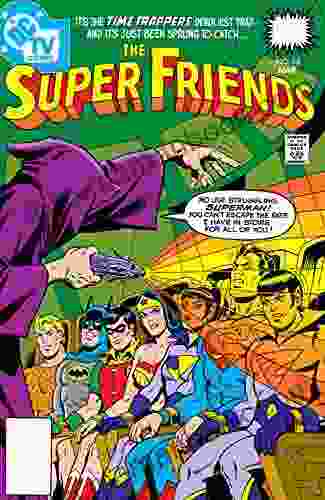The Dawn of a Design Revolution
The late 1990s and early 2000s marked a period of unprecedented innovation and design excellence at Apple. Under the visionary leadership of Steve Jobs, the company embarked on a transformative journey that would forever alter the trajectory of the tech industry. At the helm of this design revolution was a team of brilliant creatives, driven by Jobs's unwavering belief in the power of design to create products that were not only functional, but also profoundly user-centric and aesthetically captivating.
4.5 out of 5
| Language | : | English |
| File size | : | 45457 KB |
| Text-to-Speech | : | Enabled |
| Screen Reader | : | Supported |
| Enhanced typesetting | : | Enabled |
| X-Ray | : | Enabled |
| Word Wise | : | Enabled |
| Print length | : | 306 pages |
Jobs's philosophy on design was simple yet profound: "Design is not just about how it looks, but how it works." This mantra permeated every aspect of the design process at Apple, guiding the team to create products that were not merely eye-catching, but also intuitive, efficient, and an absolute pleasure to use.
The Guiding Principles of Apple Design
At the heart of Apple's design philosophy lay a unwavering commitment to minimalism, simplicity, and human-centered design. Stripped of unnecessary complexity and ornamentation, Apple products were designed to be easy to understand, operate, and enjoy. Every element, from the sleek contours of the devices to the user-friendly interfaces, was carefully considered to enhance the user experience.
Jobs believed that simplicity was the ultimate sophistication. He famously said, "Simple can be harder than complex: You have to work hard to get your thinking clean to make it simple. But it's worth it in the end because once you get there, you can move mountains." This ethos was reflected in every product Apple released during this golden age, from the iconic iMac to the revolutionary iPhone.
Beyond aesthetics, Apple's design process was deeply rooted in understanding the needs and desires of the user. The team spent countless hours observing, interviewing, and collaborating with potential users to gain insights into their behaviors, habits, and aspirations. This user-centric approach ensured that every product was tailored to meet the specific needs of its target audience, resulting in a seamless and deeply satisfying user experience.
The Importance of Iteration and Refinement
Jobs was a relentless perfectionist who believed in the power of iteration and refinement. He understood that the design process was not a linear path, but an iterative journey of constant improvement. Products were repeatedly tested, evaluated, and redesigned until every detail was perfected and the user experience exceeded expectations.
This unwavering commitment to excellence was evident in the meticulous attention to detail that characterized Apple products. Every aspect, from the tactile feel of the buttons to the precise spacing of the pixels on the display, was meticulously considered and refined through countless rounds of prototyping and testing.
Materials, Manufacturing, and Prototyping
Apple's design process extended beyond the drawing board to encompass every aspect of the product lifecycle, including materials, manufacturing, and prototyping. Jobs was deeply involved in every stage, ensuring that the highest standards were met in every aspect of production.
He believed that materials played a crucial role in the user experience, and he personally oversaw the selection of every material used in Apple products. From the sleek aluminum unibody of the MacBook to the durable glass screen of the iPhone, every material was chosen for its aesthetic appeal, durability, and tactile qualities.
Jobs also recognized the importance of manufacturing in bringing his design visions to life. He worked closely with manufacturing partners to develop innovative production techniques that ensured the highest levels of quality and precision. This attention to detail and craftsmanship was evident in the exceptional build quality of Apple products, which became renowned for their longevity and reliability.
Prototyping was an integral part of Apple's design process. Jobs understood that the best way to refine a design was to build physical prototypes and test them in real-world conditions. The team created countless prototypes, from crude early models to highly polished near-production versions. These prototypes were used to evaluate design concepts, test functionality, and gather user feedback, enabling the team to iterate and refine their designs until they reached perfection.
The Legacy of Apple's Golden Age of Design
The legacy of Apple's golden age of design is undeniable. The products created during this era redefined expectations for user experience, aesthetics, and functionality. From the iPod to the iPhone, from the iMac to the iPad, these products transformed the way people interacted with technology and left an enduring mark on the world.
Jobs's unwavering commitment to design excellence has inspired generations of designers and entrepreneurs. His belief in the power of simplicity, iteration, and user-centric design continues to shape the industry today. The legacy of Apple's golden age lives on in the countless products and services that have been inspired by its innovations, and in the enduring love and admiration of Apple users worldwide.
The design process employed by Apple during the golden age of Steve Jobs was a masterclass in creativity, innovation, and user-centric design. Guided by Jobs's unwavering belief in the power of design to transform lives, the team created products that were not only beautiful and functional, but also profoundly intuitive and deeply satisfying to use. The legacy of this extraordinary era continues to inspire and shape the tech industry today, leaving an enduring mark on the world that will be felt for generations to come.


















































































































